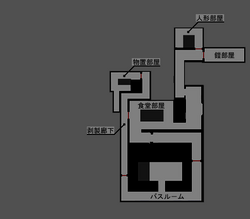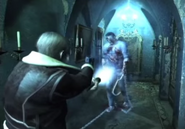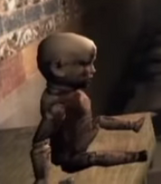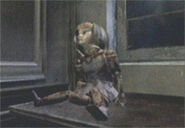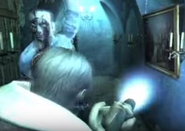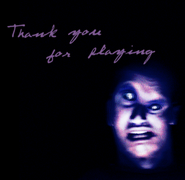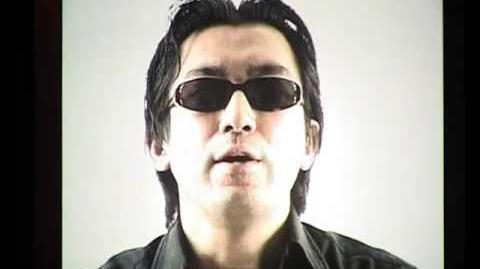"Hallucination" is the internal name given to a 2003 build of Resident Evil 4. It is otherwise known as "Hookman" in the English-speaking fandom, after a monster encountered in the E3 2003 demo, and is known to writer Yasuhisa Kawamura as "Ghost BIO" (心霊バイオ shinrei baio).[1] "Hallucination" was the second build of the game after "Castle",[2] not counting the earlier Resident Evil 4 project which became Devil May Cry. Gameplay footage of this version was featured in the Biohazard 4 Secret DVD.[3] Both "Castle" and "Hallucination" were scrapped due to technical limitations which would cost too much to resolve.
Plot[]
"Hookman was merely an experiment and there was no true back-story.
I wanted to make biohazard 4 scarier and suggested using a particular scene from the film "The Lost Souls", where the main character (played by Winona Ryder), while washing her hands in a bathroom, suddenly finds herself in a derelict building with a killer on the loose. An arranged version of this idea eventually turned into Hookman." — Yasuhisa Kawamura [4] |
"The second concept was that Leon was hit with a bizarre disease in which he started to see illusions and monsters that weren't really there. He would attack and strike out at them, but he couldn't do them any harm." — Hiroyuku Kobayashi.[5] |
Nothing is known of the "Hallucination" plot as the build was scrapped before a script could be completed. It would have included plot elements originally intended for the "Castle" build, as the developers intended to continue using the existing assets. Leon is infected with a virus in both builds, though experiences hallucinations in this build. The enemies were intended to be pseudo-paranormal in origin, being monsters existing only in Leon's mind. The E3 2003 demo showed enemy ideas such as living dolls and a hook-armed ghost coming out of a portrait, but these were likely only conceptual ideas to demonstrate the hallucinations.
Gameplay[]
Gameplay footage of "Hallucination" is comparable to "Castle" in certain aspects, such as the camera operating as a dolly-cam akin to Resident Evil Outbreak and Resident Evil CODE:Veronica, wherein it is on a pre-programmed path following the player. It should be noted, however, that the camera style changes during the "Hookman" fight, with the dolly-cam used unless Leon is aiming. Why the camera style changes here is uncertain.
Leon's handgun includes a red laser sight, and he carries a flashlight, both ideas that made it to the final game. A dodge mechanic appears in the game, similar to the release version, though "Hallucination" includes a parry mechanic where button prompts (moving the stick and pressing either the L or R trigger when prompted) allow the player to ward off an enemy's attack.

Leon using his flashlight and handgun to navigate a corridor.
No HUD or inventory menu is displayed in the "Hallucination" demo. When in Caution, the word "Caution" flashes on the bottom-right corner of the screen to highlight Leon's health problems. Incendiary grenades appear to have their own dedicated button, as they are thrown at the living dolls without requiring a menu selection.
Locations[]
According to the map ripped from "biohazard 4 trial", the demo included the following locations:
| 人形部屋 | Doll Room |
| 鎧部屋 | Armor Room |
| バスルーム | Bathroom |
| 剥製廊下 | Taxidermy Hall |
| 物置部屋 | Storage Room |
| 食堂部屋 | Dining Room |
Development[]
The "Castle" build of the game was written by recurring series writer Noboru Sugimura, and featured Leon taking part in a government raid on the castle home of Dr. Oswell E. Spencer, Earl Spencer, wherein the origins of Umbrella Pharmaceuticals and the Progenitor Virus were to be revealed. Following his departure for other projects, the script was left in the hands of Resident Evil 3: Nemesis writer, Yasuhisa Kawamura. Inspired by a scene in the 2000 film, Lost Souls, wherein Winona Ryder's character "Maya" hallucinates in a restroom, seeing the room changed to look decayed, Kawamura discussed with Shibata about incorporating a hallucination element as an alternative to B.O.W.s.[6] Kawamura believed that a more surreal take comparable to the film Jacob's Ladder would reinvigorate the franchise, as well as compete with Konami's Silent Hill franchise, which he believed was more effective in its horror style by more atmospheric and illogical.[5] A further idea, taken from John Carpenter's The Fog, was for there to be a surreal fog enveloping Leon when the enemies appear, appearing as a blue haze in the game.[1] As these elements would necessitate heavily re-writing the script to properly incorporate it, the existing script was thrown out entirely, with Kawamura expecting to recycle certain plot points in a way that would flow with Leon's illness. Sugimura would later pitch it to Kazuhiro Tsuchiya, director of the Production Studio 1 game, Haunting Ground.
Programming of the game attempted to create a game based on Kawamura's ideas, and created a system to allow for seemingly random hallucinatory enemy encounters. The system was similar to that of the 2002 remake's use of unexpected enemy encounters. In that game, events would occur by crossing an unseen checkpoint after having performed a certain task (e.g. passing a window after exploring another room). The game was planned to load both the normal and hallucinatory version of each room's 3D assets simultaneously so that switching between the two would not require more loading.[6] This had the effect of using up the GameCube's entire 24MB RAM capacity before factoring in the enemy encounters. Unable to overcome this setback without abandoning the hallucination aspect, the programmers were at best able to bring in one enemy per room.[6]
By the Autumn of 2003, Shibata ended the "Hallucination" build, and replaced it with the "Zombie" version.
Gallery[]
Images[]
Videos[]
Sources[]
- ↑ 1.0 1.1 Kawamura comment on Facebook: "いいなあ・・・ バイオ4のE3版(心霊バイオ)は、ロストソウルズのステージ変化、ザ・フォッグの霧とともに現れる敵(目を光らせたかった・・・)を参考コンセプトに加えて企画していたな・・・。ザ・フォッグはすごくクール。"
- ↑ Travis Fahs (March 11, 2009). IGN Presents the History of Resident Evil. IGN. Retrieved on July 17, 2010.
- ↑ Juan Castro (January 26, 2005). RE4 Bonus Disc Footage. IGN. Retrieved on July 18, 2010.
- ↑ Yasuhisa Kawamura Interview (Project Umbrella). Project Umbrella. Retrieved on 2013-06-24.
- ↑ 5.0 5.1 Heidi Kemps (September 27, 2004). Hiroyuki Kobayashi on Resident Evil 4 & Killer 7. GameSpy. Retrieved on July 18, 2010.
- ↑ 6.0 6.1 6.2 Yasuhisa Kawamura and the Resident Evil that never was. Eurogamer. Retrieved on 2019-07-08.
| |||||||||||||||||||||||
| ||||||||||||||||||||||||||||||||||||||||||||||

